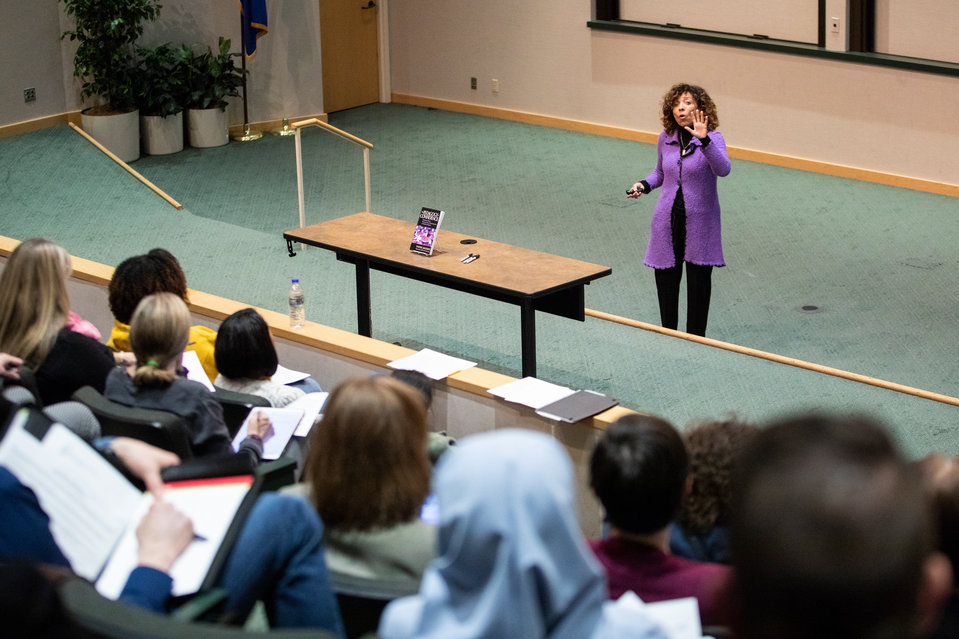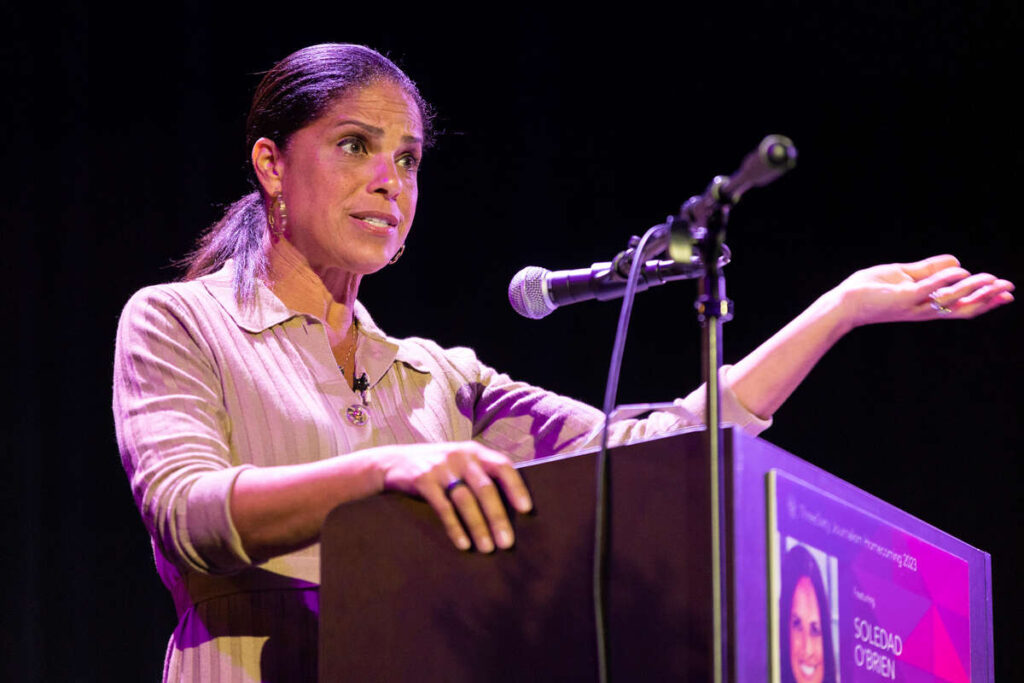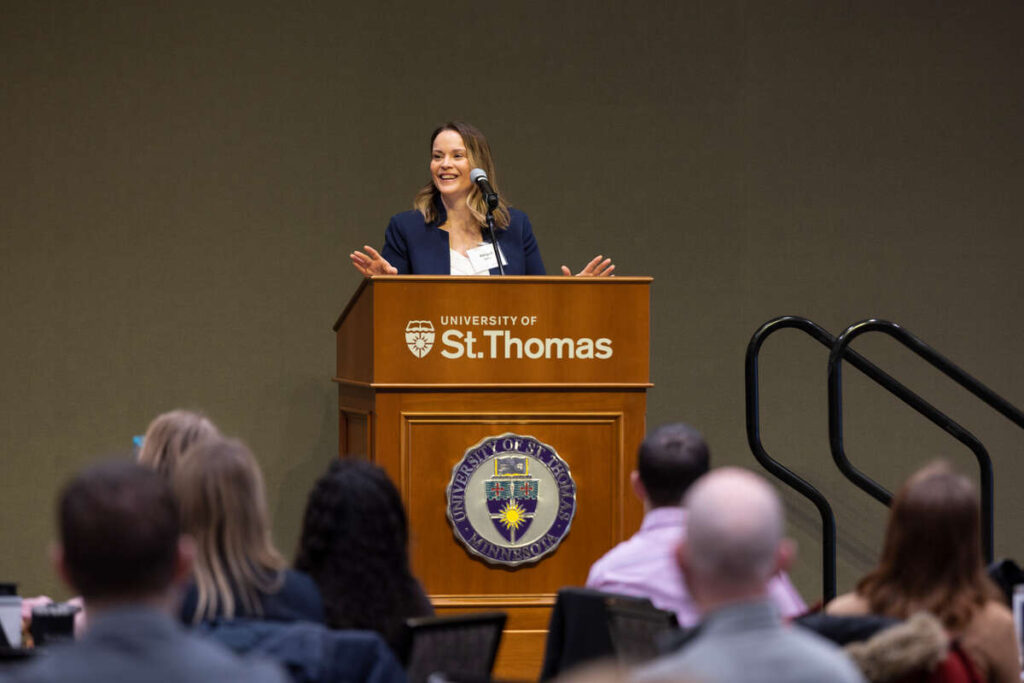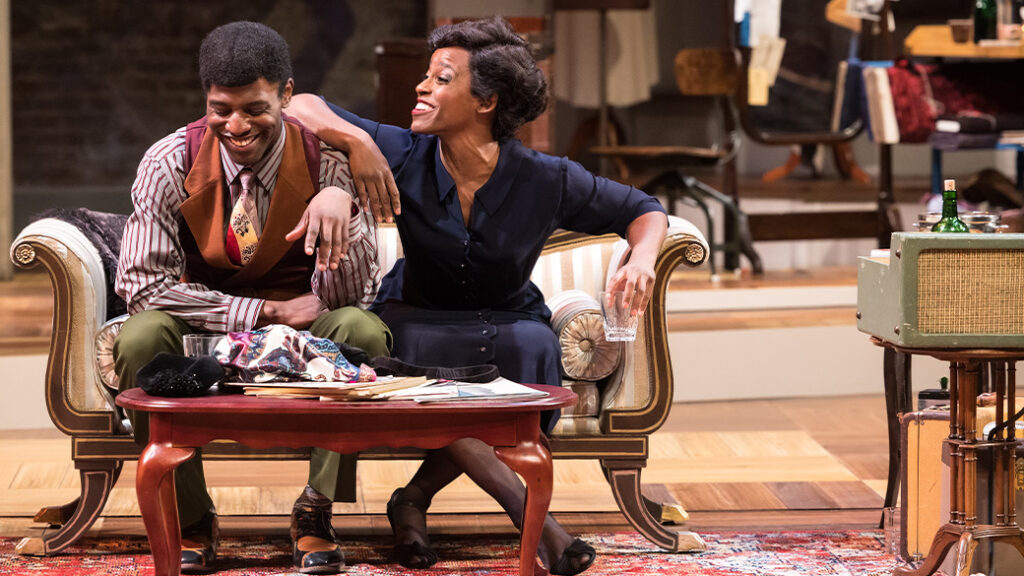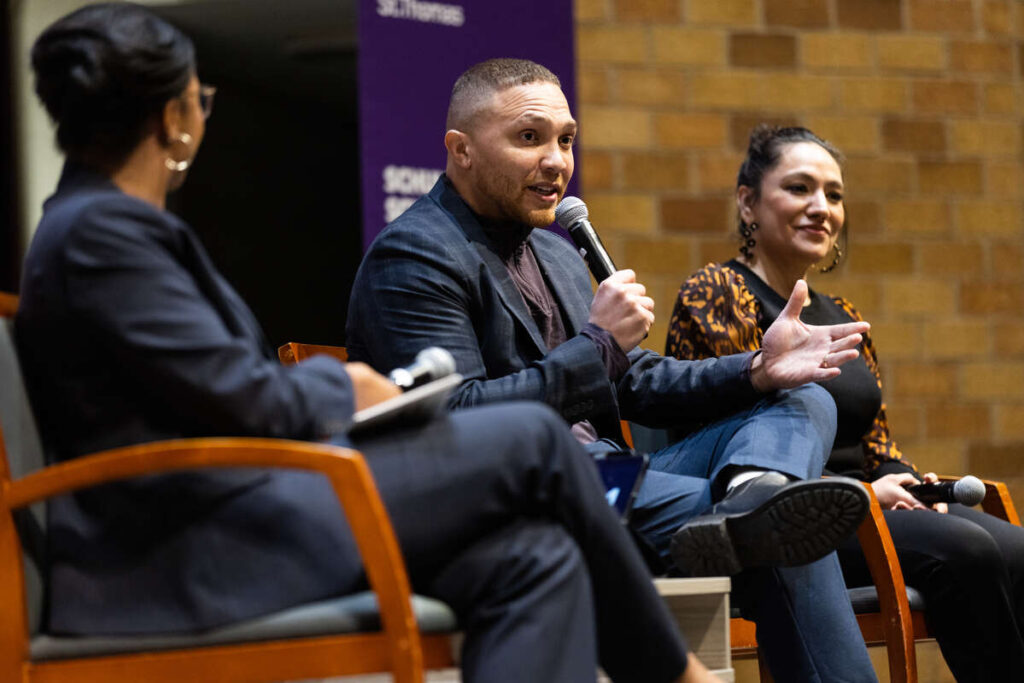In collaboration with the University of St. Thomas School of Education and the African American Registry, the May Dean’s Forum featured Dr. Yvette Jackson speaking on “Pedagogy of Confidence: Cultivating Equity Consciousness Through a Focus on Strengths” at Thornton Auditorium in Terrence Murphy Hall.
An adjunct professor at Teachers College, Columbia University, and author of The Pedagogy of Confidence, Jackson talked about how educators have the ability to focus on students’ strengths instead of their “deficits” to achieve high intellectual performances.
“There is one gap we should try to close and that is between potential and what a child is achieving,” Jackson said.
She took an attentive audience through her “High Operational Practices,” which included insights on how to provide enrichment and amplify student voices to identify strengths and elicit high intellectual performance. People were asked to interact with one another throughout the presentation, sparking interesting conversations on everything from one’s strengths to thoughts on cultural identity.
The Dean’s Forum was initiated by the School of Education Dean Kathlene Holmes Campbell and builds off the work of Teachers College, Columbia University’s Racial Literacy Lecture Series. In this ongoing series, the School of Education community participates in candid conversations about race, equity and education.
Here are five observations from Jackson’s talk.
Educators need to embrace their giftedness
“How many people in here are gifted educators?” Jackson asked the room at the beginning of her lecture. After few hands were raised, she pointed out that was a problem. As an educator, you have a gift for working with people, she said, pointing out that not everybody is equipped to be a teacher.
“How do you bring out the innate potential for giftedness in others if you don’t think you have it yourself? Seriously, think about that,” she said. “If you don’t think you have it in yourself, then you think others don’t have it and maybe you won’t look for it. The ‘other’ is the people you work with. If you don’t feel that you are gifted, they pick up on that vibe, especially if you are working with students.”
Jackson said it’s like when you’re on a plane and the flight attendant is going over emergency protocol. You’re instructed to put your oxygen mask on first and then help others.
“Part of this is cultural,” she said. “We as educators have not been taught to talk about our giftedness. You are also in Minnesota where you have a servant leadership philosophy. Except, how do you serve if you’re not serving with your gifts?”
What happens in the classroom is a conduit for equity
A focus on students’ strengths inspires learning and high intellectual performance. To embrace equity consciousness you have to understand everyone has an innate propensity to develop those strengths, Jackson said.
“It doesn’t matter where I’m working,” she said. “When I ask people to define equity for me, they have some problems. Nobody has come up with what equity in the classroom looks like. But what if I ask you what you think a gifted education looks like in a classroom?”
People in the room quickly offered up a number of suggestions of what a gifted classroom might have, including personalized learning, challenges and inclusiveness. Jackson said all classrooms should offer what gifted programs do.
“That's why we have to disrupt the narrative and say the way we get to equity is gifting all students – giving them all of the opportunities you would identify in a gifted program,” Jackson said. “Gifting all students with support to elicit and nurture the innate potential for self-actualization and contribution. It's about having students believe in themselves to the point that they are so determined that they will make goals and reach them. The other side of it is our work here and when I say equity consciousness, I'm saying this is the work of education to be able to have students thrive and flourish in the world.”
Cultural identity helps with engagement
You cannot assume to know someone’s culture by just looking at them, Jackson said, because a person’s whole cultural frame includes everything that is meaningful and relevant to them. Race and ethnicity are part of a person’s culture, but not all of it. Jackson asked people to reflect on their own culture and share their thoughts with one another.
“When you break it down, you might find more commonalities than you even expected,” she said. “I wanted you to reflect on your own frame because sometimes you don’t think about that. I wanted you to share because I wanted to you to see what binds us together is humanity.”
Jackson said when we start comparing our cultural frames, we begin to feel a sense of belonging and connectedness.
“This is how we have to start developing in our programs, whether it's in an elementary school or here at St. Thomas,” she said. “We have to look at how we can work on what we have that unites us."
“Yes, there is diversity and we respect it and value it because of how it can affect our creativity,” she added. “Because now we have a lot of different perspectives. Sometimes the frame can be binding. What we’re trying to do is open the aperture so it gets bigger and bigger.”
Our cultural frames keep evolving, she said, as we are exposed to different things. Teachers might be surprised to see what children have in their frames and what is discovered through this type of communication.
Building relationships is key
Children do better academically when are in a classroom with teachers who believe in them and take time to cultivate relationships. A strong relationship between educators and students helps learners enhance their strengths and build up self-determination.
“When you are building relationships and you're starting to talk about your strengths together, you're letting off not only oxytocin, but also endorphins and dopamine, which makes learning happen,” Jackson said. “Kids look forward to being in that class. It doesn’t matter what age they are. They just think, ‘I feel good.’
“That is also true even with teachers who are very hard on them, but love them and act like they love them,” she added.
Don’t make students feel like they are ‘other’
Labeling someone as a minority can have the power to make them feel "less than" others, said Jackson. To disrupt the narrative, we have to use language that doesn’t make students feel like they are “other.”
“It’s pervasive, it’s in all the forms from the federal government,” Jackson said about identifying race and ethnicity on paperwork. “You don’t have to use those terms. We can change the lexicon. If all kids have the innate ability for high intellectual performances, they have to feel valued, they have to feel they belong and they have to feel you believe."
“You can’t change the tests that come from the fed and the state, but you can change and be much more aware of what you are choosing to assess people on,” she said. “What are you asking of the kids?”
